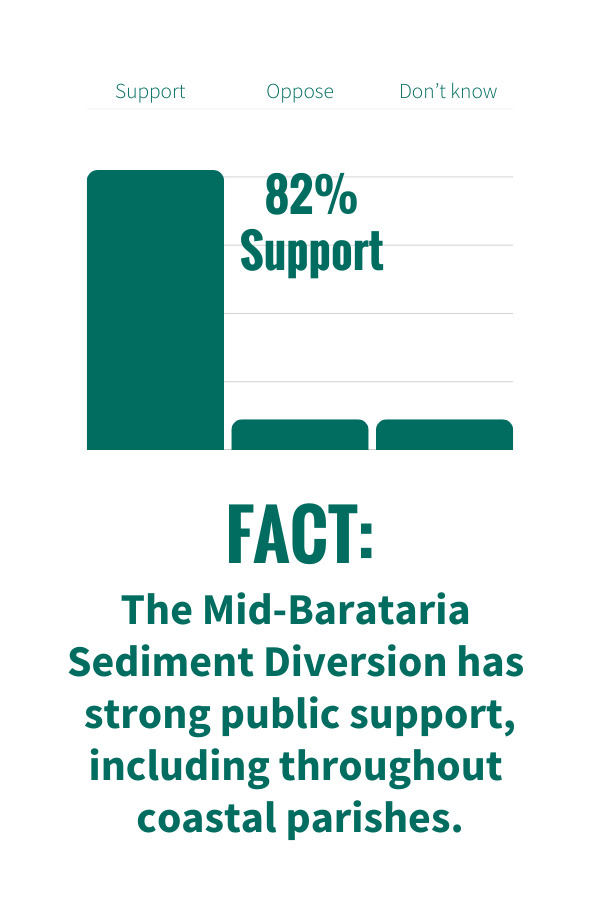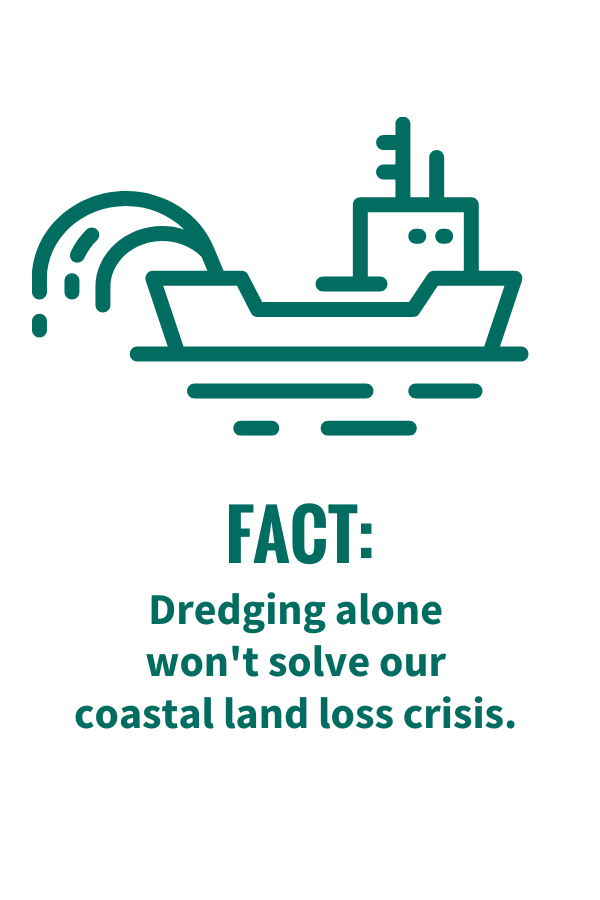Louisiana has lost more than 2,000 square miles of wetlands in less than a century—and the loss continues by the minute. A major cause of this land loss crisis is the leveeing of the Mississippi River, which cuts off the sediment that once built and sustained these wetlands. Reconnecting the Mississippi River to its wetlands is fundamental to restoring coastal Louisiana;
The Mid-Barataria Sediment Diversion is Louisiana’s most critical restoration project, using the power of the Mississippi River itself to restore Louisiana’s natural land-building processes. It will reconnect the river to adjacent wetlands and restore the natural balance that built south Louisiana in the first place.
While concerns about potential impacts exist, the state is investing hundreds of millions in mitigation to address them. What is not an option is doing nothing—the cost of inaction is continued land loss, weakened storm protection and increased risk to communities.
Despite broad public support, including in coastal parishes, misinformation about the project has led to confusion. Some opponents have exaggerated concerns while ignoring the reality that no alternative can restore land at the scale and speed needed.
The fact is, Louisiana’s coast is vanishing, and the Mid-Barataria Sediment Diversion is a proven, science-backed solution to help save it.
Setting the Record Straight
Let’s take a look at some of the facts about the project and set the record straight.
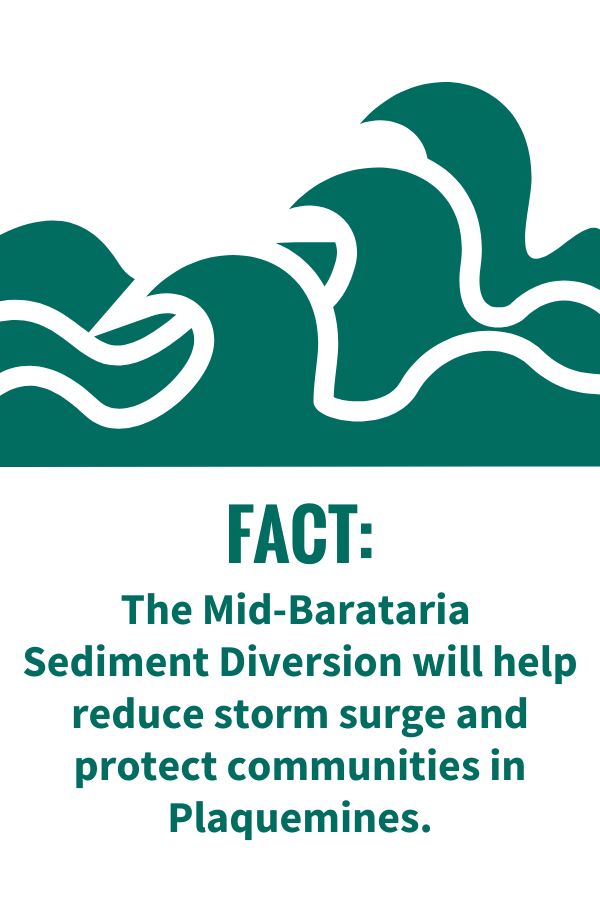
fact: The Mid-Barataria Sediment Diversion will help reduce storm surge and protect communities in Plaquemines Parish.
- Introduces 5.5M tons of sediment/year, creating 5,000 acres of wetlands in 10 years, 17,000 acres in 30 years—helping counter sea level rise.
- Wetlands reduce storm surge by up to 1 foot per 2.7 miles, protecting Plaquemines, Jefferson, and Orleans Parishes.
- Maximum 75,000 cubic feet/sec flow occurs only during high river levels (spring/summer floods); gates close during storms.
- FEMA confirms no flood insurance rate increases for Plaquemines Parish.
- CPRA allocated funds for mitigation (raising homes, roads, piers, improving sewers) to enhance local resilience.
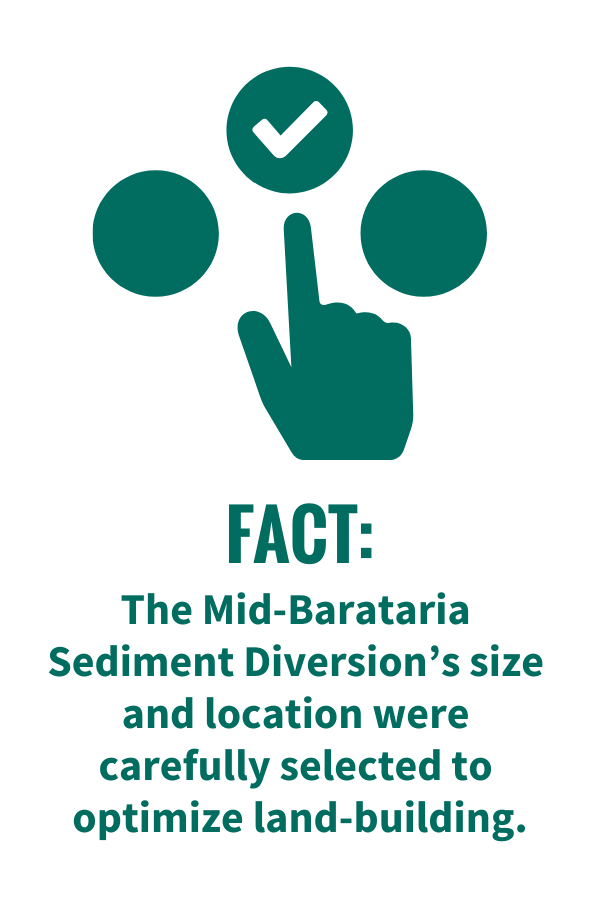
FACT: The Mid-Barataria Sediment Diversion is the most cost-effective solution for land building.
- A diversion was first proposed in Myrtle Grove in 1984.
- Decades of studies show larger diversions capture significantly more sediment.
- A 75,000 cfs diversion captures 9x more sediment than a 15,000 cfs diversion.
- Modeling from the 2012 Coastal Master Plan found multiple small diversions were less effective.
- Without diversions, land-building would be reduced by 300+ square miles.
FACT: The Mid-Barataria Sediment Diversion has strong public support, including throughout coastal parishes.
- A 2025 poll found 82% of Louisianans and 85% of coastal parish residents support sediment diversions.
- In 2024, 80+ Plaquemines Parish residents, including commercial fishermen, backed the diversion in a letter to Gov. Landry.
- CPRA has held 316 meetings with 12,000 stakeholders over 4 years, including elected officials, industry members, and the public.
- Outreach and engagement efforts are ongoing to guide project implementation and mitigation plans.
Fact: Dredging alone won’t solve our coastal land loss.
- 20 dredging projects planned to restore 15,000 acres, but it’s not enough.
- Dredging doesn’t address subsidence, hurricanes, or sea level rise.
- Sediment diversions are necessary to deliver regular sediment to wetlands.
- Without action, 55% of Plaquemines Parish could disappear in 50 years.
- CPRA’s 2012 Master Plan says sustainable restoration needs sediment diversions.
- Dredging is more expensive and less effective than diversions.
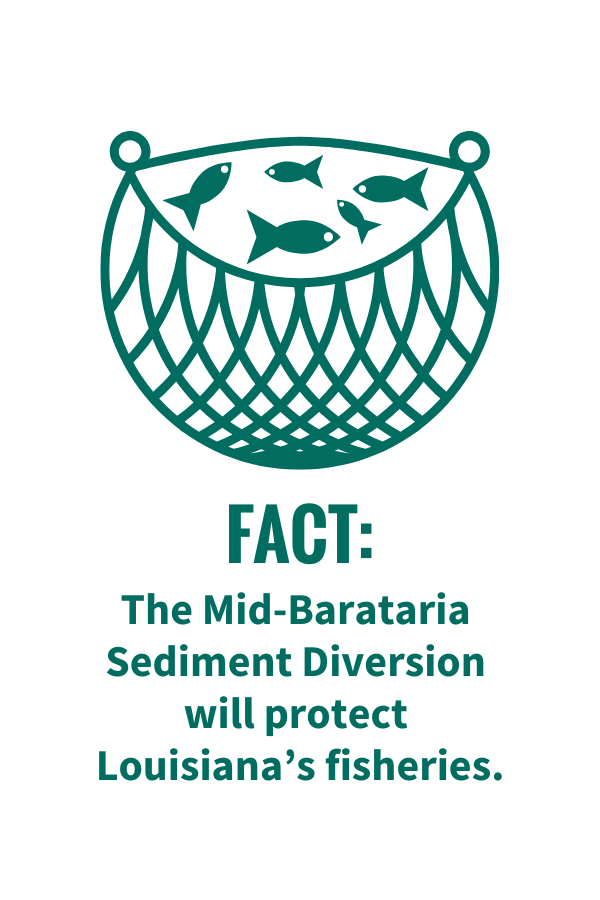
Fact: The Mid-Barataria Sediment Diversion will protect Louisiana’s fisheries.
- The Barataria Basin is collapsing due to wetlands loss.
- The diversion will restore balance and benefit species like shrimp and oysters.
- Millions are being invested in mitigation to help fishers adapt.
- Without the diversion, fishing communities will continue to struggle.
- Areas where sediment is restored show thriving ecosystems and fisheries.
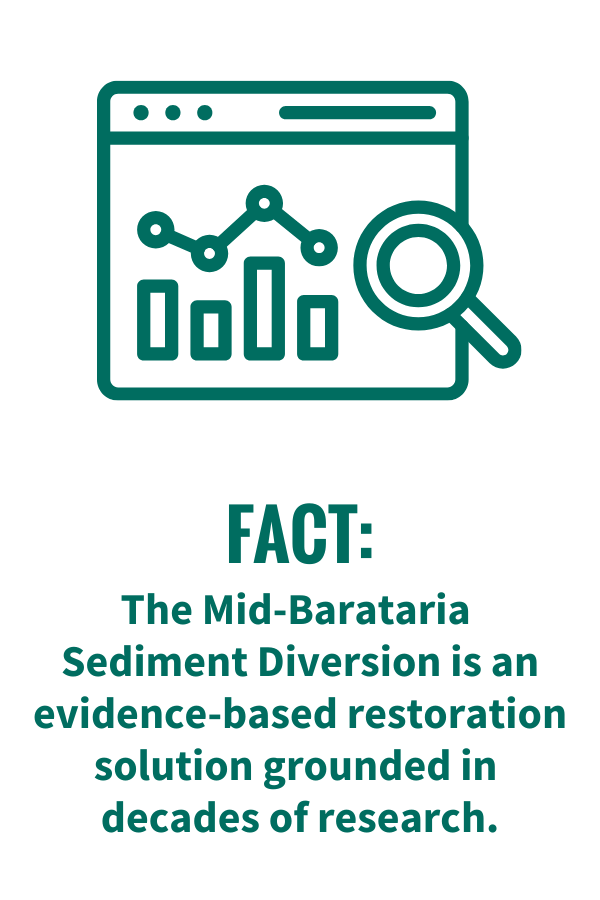
Fact: The Mid-Barataria Sediment Diversion is an evidence-based restoration solution grounded in decades of research.
- The Mississippi River built Louisiana’s wetlands over millennia.
- The Mid-Barataria Sediment Diversion is the most significant restoration project in Louisiana’s history.
- MBSD will restore thousands of acres of wetlands, providing a buffer against storm surge and revitalizing ecosystems.
- A consensus of scientists has recognized reconnecting the river to wetlands as essential for a sustainable future for nearly 50 years.
- The river continues to build land where connected to wetlands, as seen in areas like Plaquemines Parish.
- MBSD is designed to enhance the river’s natural land-building power to combat sea-level rise and subsidence.
The World Needs More Louisiana – Not Less
The overwhelming public support for the Mid-Barataria hasn’t changed. The need for Mid-Barataria has only become more urgent. Only the politics has changed – and that is deeply concerning for Louisiana’s future.
Coastal Louisiana is disappearing faster than anywhere else in the U.S. But we have the tools to rebuild it – and to save our unique cultures, critical wildlife habitat and nationally-significant industries and infrastructure.
The Mid-Barataria Sediment Diversion (MBSD) is the single most important restoration project to protect our land, communities, and way of life. MBSD uses the power of the Mississippi River itself to rebuild Louisiana’s vanishing wetlands—mimicking the natural processes that built our delta in the first place.
Louisiana’s coastal program was built on prioritizing science and public good over politics, but it is now in jeopardy.
Recent comments by Governor Landry signal a dramatic shift in that science-based philosophy and it’s time to step up to protect Louisiana’s coast. The MBSD is the most studied and most important project in Louisiana. This project will reconnect the Mississippi River with its sediment-starved wetlands to build new wetlands and sustain nearby marsh.
It’s time to step up to protect Louisiana’s coast. Sign the form and pledge your support for the Mid-Barataria Sediment Diversion.
